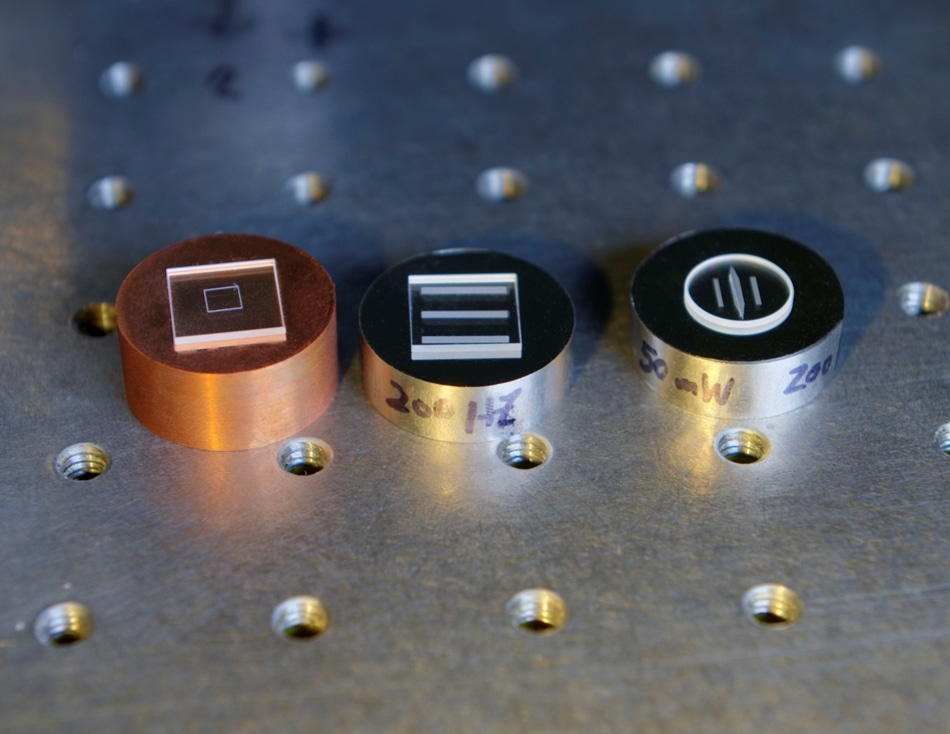Nov 2 2018
An ultrafast laser capable of firing pulses of light just 100 millionths of a nanosecond in duration could possibly transform the way that NASA engineers manufacture and ultimately assemble instrument components composed of dissimilar materials.
 A Goddard team is using an ultrafast laser to bond dissimilar materials, with the goal of ultimately eliminating epoxies that outgas and contaminate sensitive spacecraft components. Shown here are a few samples (from left to right): silica welded to copper, silica welded to Invar, and sapphire welded to Invar. (Image credit: NASA/W. Hrybyk)
A Goddard team is using an ultrafast laser to bond dissimilar materials, with the goal of ultimately eliminating epoxies that outgas and contaminate sensitive spacecraft components. Shown here are a few samples (from left to right): silica welded to copper, silica welded to Invar, and sapphire welded to Invar. (Image credit: NASA/W. Hrybyk)
Optical physicists at NASA’s Goddard Space Flight Center in Greenbelt, Maryland, are conducting experiments with a femtosecond laser and have already demonstrated that it can efficiently weld glass to glass, glass to copper, and drill hair-sized pinholes in various materials.
Now the team, led by optical physicist Robert Lafon, is widening its research into more exotic glass, such as Zerodur and sapphire, and metals, such as titanium, Kovar, Invar, and aluminum—materials repeatedly used in spaceflight instruments. The aim is to weld larger pieces of these materials and demonstrate that the laser technology is effective at sticking windows onto laser housings and optics to metal mounts, among other applications.
With assistance from the Space Technology Mission Directorate’s Center Innovation Fund program, the team is also looking at the technology’s use in fabricating and packaging photonic integrated circuits, an up and coming technology that could profit everything from communications and data centers to optical sensors. Although they are like electronic integrated circuits, photonic integrated circuits are fabricated on a combination of materials, including silicon and silica, and use infrared or visible light, instead of electrons, to convey information.
“This started as pure research, but now we hope to start applying what we have learned to the fabrication of instruments here at Goddard,” Lafon said, denoting the work he and his team, including Frankie Micalizzi and Steve Li, are using to experiment with various materials and methods that could profit spaceflight applications. “We already see what the applications could be. In this case, research for research’s sake is in our best interests,” Lafon said.
The Technology’s Virtues
Crucial to promoting these applications is the laser itself. As a result of its short pulses—measured at one-quadrillionth of a second—an ultrafast laser interacts with materials in an exclusive way, Lafon said. The laser energy does not melt the targeted material; instead, it vaporizes it without heating the adjoining matter.
Consequently, technicians can exactly target the laser and bond dissimilar materials that otherwise could not be adhered without epoxies. “It’s not possible to bond glass to metal directly,” Lafon said. “You have to use epoxy, which outgases and deposits contaminants on mirrors and other sensitive instrument components. This could be a serious application. We want to get rid of epoxies. We have already begun reaching out to other groups and missions to see how these new capabilities might benefit their projects.”
Another vital application is in the area of micromachining. “The ability to remove small volumes of material without damaging the surrounding matter allows us to machine microscopic features,” Lafon added.
Microscopic characteristics include everything from drilled, hair-sized pinholes in metals—an application the team already showed—to etching microscopic channels or waveguides through which light could travel in laser transmitters and photonic integrated circuits. The same waveguides could permit liquids to flow through microfluidic devices and chips necessary for instrument cooling and chemical analyses.
Widespread Applicability to NASA Projects
“Ultrafast lasers offer fundamental changes in how we can microprocess materials,” said Ted Swanson, senior technologist for strategic integration at Goddard. “The team’s work on this research effort will allow Goddard to adapt this emerging technology to a wide variety of flight applications.”
With that goal, the team—between working on numerous NASA’s high-profile laser communications projects, including the Laser Communications Relay Demonstration—plans to put together a library of micromachining and welding capabilities. “Once we are able to demonstrate this capability reliably, we will attempt to apply it to existing challenges here at Goddard. Our initial research is showing that this technology could be applied to a large number of projects across NASA,” Lafon said.